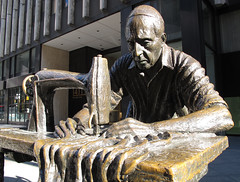Sidney's Picks: Highlights of 2011

Our 2011 Sidney Award Winners, of course. But that would make for a pretty anticlimactic list, wouldn’t it? You already know we think the world of them.
- Punched Out: The Life and Death of a Hockey Enforcer, by John Branch in the New York Times. A heartbreaking and painstakingly reported multimedia package about the life and death of 28-year-old NHL player Derek Boogaard, an “enforcer” whose history of head trauma probably contributed to his untimely death from a drug overdose.
- Birthright: What’s Next for Planned Parenthood by Jill Lepore in the New Yorker. How did Planned Parenthood become synonymous with abortion? The answer may surprise you. This essay uses early controversies over birth control as a lens to understand the modern anti-abortion movement.
- The Red Market: On the Trail of the World’s Organ Brokers, Bone Thieves, Blood Farmers, and Child Traffickers by Scott Carney, published by William Morrow. An anthropologist-turned-investigative journalist travels the world to document the commodification of the human body and its functions.
- A Vicious Cycle in the Used Car Business, by Ken Bensinger in the LA Times. This meticulous investigation details how national chains of self-financing used car dealerships exploit the poor and repackage their bad loans as subprime securities.
- The High Price of Looking like Woman by Laura Rena Murray in the New York Times. Local reporting at its best. Murray delves into the underworld of unlicensed silicone injectors who prey on transgender women in New York seeking feminine curves on the cheap. This story is especially powerful because it illustrates how transphobia and discrimination push vulnerable women into this potentially lethal black market.
- Deep Intellect: Inside the Minds of Octopuses, by Sy Montgomery in Orion Magazine. The author seeks understand how octopuses can be so smart, yet so different from humans–physically and evolutionarily. His search brings him to embrace an octopus. He also interviews octopus scientists, a scuba diving philosophy professor, and an aquarium volunteer who found his post-retirement calling as an octopus whisperer.
- The Luckiest Woman in the World: Three Ways to Win the Lottery by Nathaniel Rich in Harper’s. Wannabe grifters take note.
- Is The SEC Covering Up Wall Street Crimes?, by Matt Taibbi in Rolling Stone. Ditto.









